Minimizing Nitrate Leaching From Cropland
Use fertilizer and crop management practices to minimize nitrate leaching, benefit crop production and protect groundwater quality.
Last Updated: 01/18by Clain Jones, Extension Soil Fertility Specialist/Associate Professor; and Kathrin Olson-Rutz, Research Associate, Department of Land Resources and Environmental Sciences
WHAT IS NITRATE?
Nitrogen (N) is important for optimal crop production. Nitrate is a form of N that is available for plant uptake. It is highly soluble and easily lost to leaching as water moves through the soil profile. Based on Montana Department of Agriculture testing, high nitrate in groundwater exists in many agricultural areas of Montana (Figure 1). High amounts of nitrate in drinking water can be harmful, especially to infants and pregnant women. They also represent a direct financial loss to Montana agriculture. It is estimated Montana groundwater contains over 1 billion dollars worth of leached N. In addition, nitrate leaching can contribute to soil acidification (1), an emerging issue in parts of Montana.
WHAT ARE SOURCES OF NITRATE?
Nitrate can come from traditional fertilizer or organic matter mineralization (decomposition) and manure. Although most N fertilizers used in Montana do not contain nitrate, dissolved fertilizer and decomposed organic matter will produce nitrate through the process of ‘nitrification’. This process can occur in a few hours or over many months.
FIGURE 1. Nitrate-N concentrations in wells sampled at least annually from 2012-2017 (Provided by the Montana Department of Agriculture, Groundwater Protection Program).
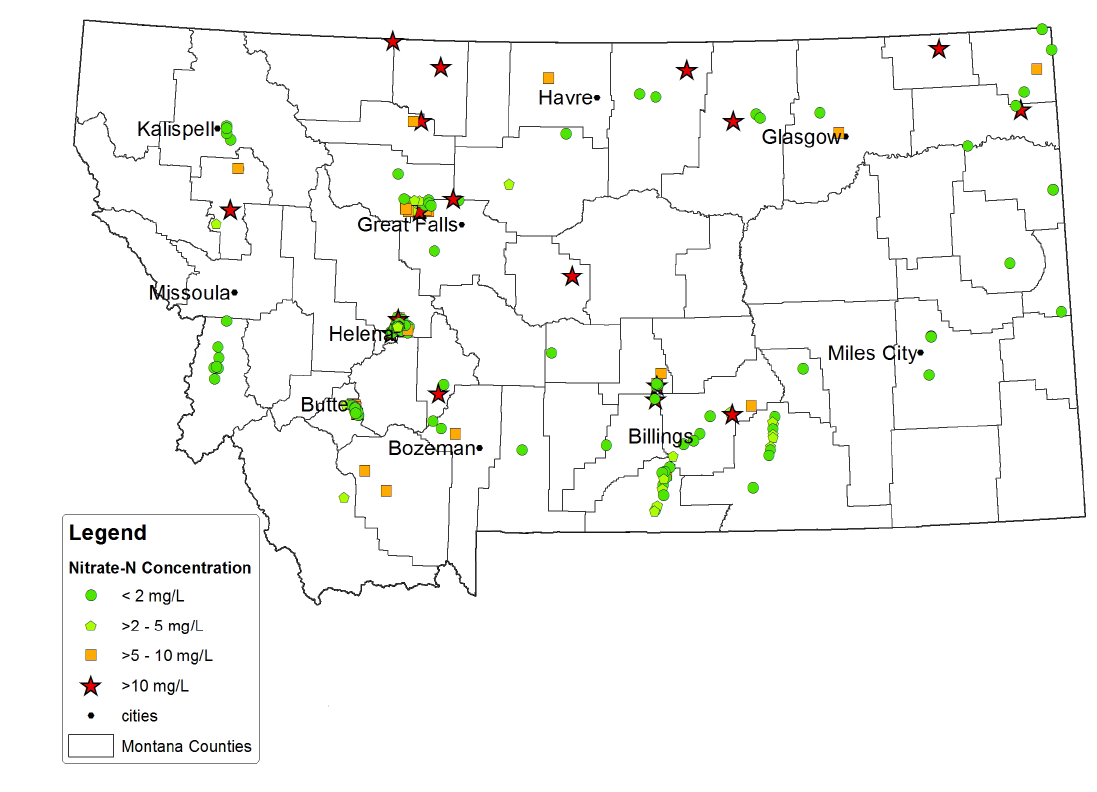
The soil ecosystem contains very large amounts of N, mostly held in organic matter (Table 1). Plant roots take up and retain soil N, especially in untilled rangeland soils. Only a small portion of soil N is present as nitrate. Cultivated fields can have about 30% less N than nearby native range due to increased decomposition rates, more water that moves below the root zone taking nitrate with it, and N removal at harvest.
Fallow fields build up nitrate levels, which come from decomposing organic matter, since no fertilizer is being added (Figure 2, page 2). Fallow fields enter winter with far more nitrate than cropped fields because they have had a whole season to accumulate nitrate. Without active roots to take up nitrate or water, the chance for overwinter nitrate leaching is much greater on fallow than on recropped fields.
Table 1. August nitrogen (N) levels in soil organic matter and roots and as nitrate in fallow, winter wheat and native range in central Montana (2).
| Land use | N in organic matter | N in plant roots | N in soil as nitrate |
| lb N/acre to 30-inch depth | |||
| Native range | 17,000 | 220 | 6 |
| Winter wheat | 12,000 | 5 | 13 |
| Fallow | 12,000 | 0 | 62 |
Nitrate can also come from saline shale formations, but the relative contribution of nitrate from shale depends on a variety of factors, including the type of shale. Nitrate from septic systems or livestock can be substantial, but this bulletin only addresses nitrate from cropland.
IS NITRATE LEACHING A PROBLEM IN MONTANA?
Most groundwater in Montana has nitrate levels below the drinking water standard (10 mg nitrate-N/liter or parts per million). Yet, high nitrate levels can be found throughout the state, particularly in residential areas that have a high density of septic systems and some agricultural areas.
WHAT LEADS TO NITRATE LEACHING?
When rainfall or irrigation exceeds soil water storage and plant water uptake, the extra water moves down below the root zone and eventually into groundwater, taking nitrate with it.
Whether soil nitrate ends up entering groundwater depends on many factors, including the depth to groundwater, depth to a gravel layer, soil texture, precipitation amounts and timing, evapotranspiration, and rooting depths. Fortunately, in Montana soil texture is often fine and deep-rooted crops such as winter wheat and alfalfa are common, which minimize leaching, and drinking water often comes from uncontaminated deep wells. Yet there are areas in the state that have a high potential for leaching and groundwater contamination.
FIGURE 2. Nitrate accumulation in top 6-inches from April through November on two fields in central Montana, each with a portion in fallow and another in field pea (3).
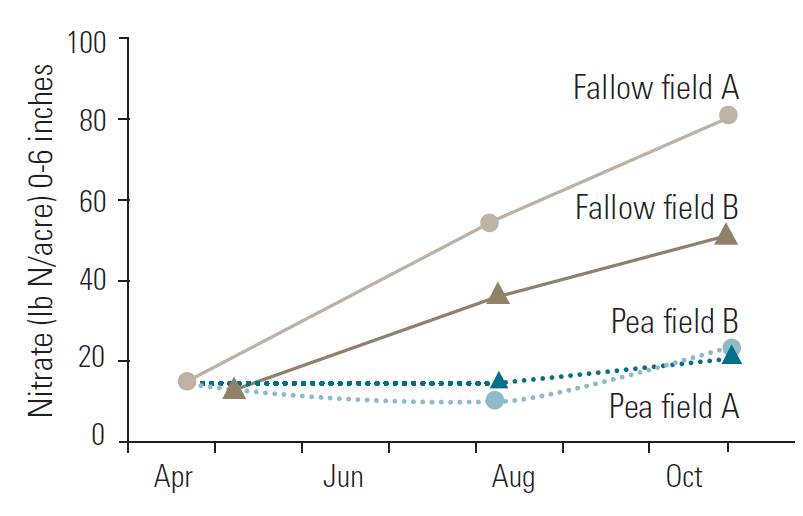
SOIL AND WATER FACTORS THAT INCREASE LEACHING POTENTIAL
Soil texture influences a soil’s ability to retain water (Table 2). Sandy or gravelly soils, soils with large cracks or channels created by roots or animals, and shallow soils have low water holding capacity. Cracks and other vertical channels such as from decomposed roots that extend from the soil surface to below the root zone allow water to move nitrate downwards. There is little producers can do to change these soil properties.
Irrigated fields have the highest potential for leaching, especially on coarse soil. In dryland conditions, nitrate leaching is likely insignificant during much of Montana’s growing season because plant uptake of water usually exceeds precipitation, preventing downward movement of water. However, in fall and winter there is little to no plant uptake of water, resulting in increased potential for nitrate leaching. Heavy spring rains, especially on shallow soils, can also lead to leaching (4, Montana).
MANAGEMENT
There are several crop, irrigation and fertilizer management practices that help minimize nitrate leaching potential.
TABLE 2. Plant available water holding capacity for various soil textures.
| Soil texture | Inches water per foot of soil |
| Sand, fine sand | 0.72 |
| Loamy sand | 0.96 |
| Sandy loam | 1.44 |
| Loam, silt loam, silt, sandy clay, silty clay, clay | 2.04 |
| Sandy clay loam, clay loam, silty clay loam | 2.16 |
If the soil is 1 foot sandy loam over 2 feet sandy clay loam, it would take (1.44) + (2 x 2.16) = 5.8 inches of water to refill the dry soil to a 3 foot depth. More precipitation or irrigation could leach nitrate.
Crop Management
Limiting water flow below the root zone will reduce downward nitrate movement. In dryland cropping systems, reducing fallow is likely the most important management option to accomplish this. Fallow fields build up nitrate through organic matter decomposition and have no crop in place to take up N. If they reach field capacity (the amount of water a particular soil can hold against drainage) additional precipitation is likely to push soil water below the rooting zone, taking nitrate with it. As cropping frequency increases, nitrate leached decreases (Figure 3).
In a study in the Judith River watershed, replacing fallow with pea substantially reduced nitrate leached in one of two study years (pea leached 16 lb N/acre; fallow, 48 lb N/acre; 4, Montana). Annual legumes in place of fallow not only use soil water, they are good scavengers of available N in the upper two to three feet, and do not need N fertilizer as long as sufficient phosphorus (P), potassium (K), sulfur (S) and the correct inoculants are used to optimize N fixation.
Based on another Montana study, the benefit of recropping (legume grain-winter wheat) compared to fallow-winter wheat on reducing soil nitrate levels appears to be more of an effect of capturing water than reducing N rate. As expected, spring nitrate levels after winter wheat increased in the fallow system as the available-N (fertilizer-N + soil-N) increased (Figure 4). However, in the legume grain-wheat system, total nitrate was minimally affected by N rate applied during the wheat rotation and was overall lower than in the fallow-wheat system. It is highly likely any nitrate in the fourth foot of soil in the spring after a wheat year will not be scavenged by winter wheat planted the following growing season and will eventually be lost to groundwater. This ‘lost’ amount was greater in fallow- wheat than legume grain-wheat at all N rates except zero N.
FIGURE 3. Soil nitrate after 37 years of dryland fallow-wheat
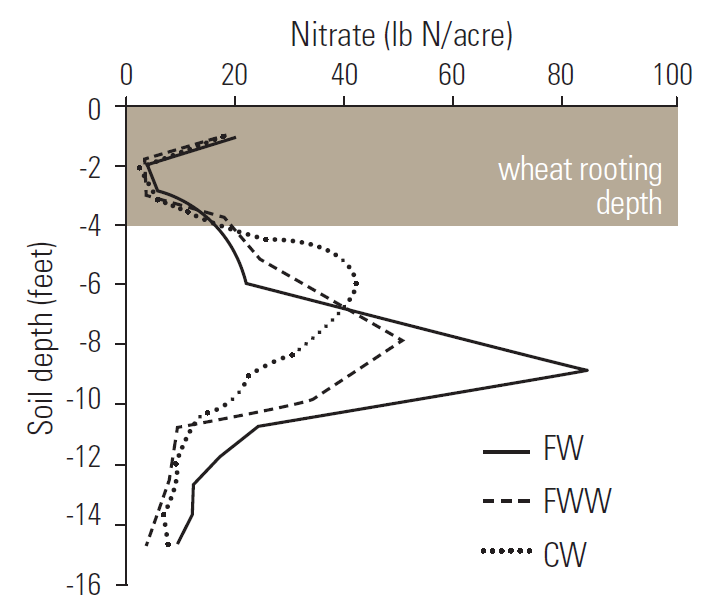
The importance of recrop to capture N and hold water depends on the precipitation pattern. In a wet spring, residue decomposition and nitrate production is greater than in a dry spring so it is more important to have a crop to take up that nitrate. Cereal forages, green manures and cover crops can be used to manage crop available water in areas with insufficient precipitation for continuous cropping, but with more precipitation than can be used by crop-fallow.
FIGURE 4. March soil nitrate in 1-foot increments after wheat in fallow-wheat or legume grain-wheat at four available-N rates (3, Montana).
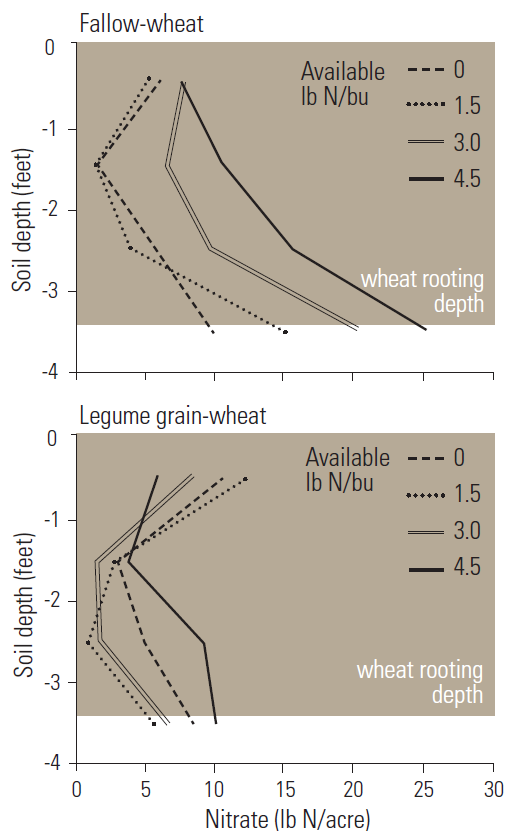
In high N input systems, which are often irrigated (e.g., sugarbeet, potato, corn, vegetables), cover crops can be very important to scavenge residual N between crops. Non-legume cover crops in such systems reduced leaching by an average 70%, while legume cover crops reduced leaching by 40% (6).
Planting perennials or deep-rooted annual crops such as sunflower, safflower, winter wheat, canola and triticale helps use water and N that may escape shallow- rooted crops (Figure 5). While alfalfa is an excellent scavenger of soil nitrate, the large supply of N remaining after alfalfa is terminated can release nitrate. To avoid leaching loss of this nitrate, fields should be recropped rather than fallowed after alfalfa termination and N from alfalfa residue credited in fertilizer N rate calculations (~40 lb N/acre) to avoid over fertilization.
FIGURE 5. Six-year average groundwater nitrate-N under spring wheat/barley, sugarbeet and safflower during the growing season (7, Montana).
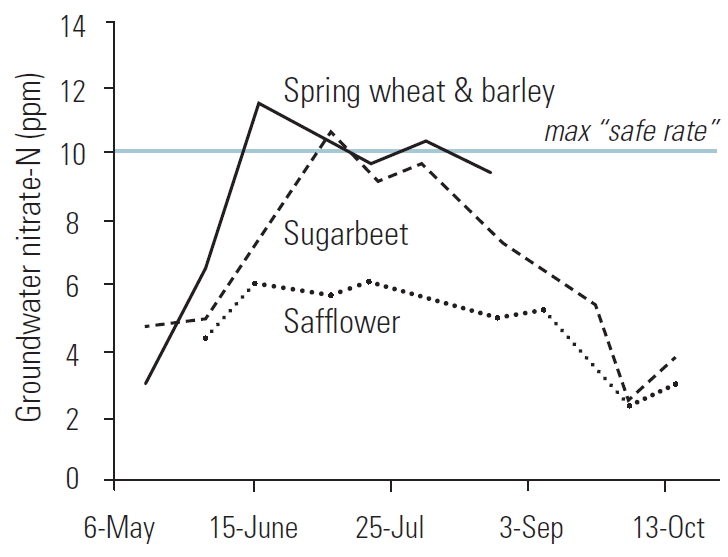
After fallow, fall-planted crops are ideal because they start taking up N in the fall, have well established root systems by spring to reach sub soils more quickly, and leave a shorter fallow period than spring planting (~12 vs. 20 months). A shallow-rooted crop that produces relatively low biomass, such as flax, draws less deep water and removes less N from the soil, thus it is not ideal after fallow.
Seeding rates and row spacing for optimal plant density can increase yields and optimize N and water use, which will decrease leaching potential. For example, spring wheat had a higher efficiency of N fertilizer use at 6-inch row spacing than at 12-inch spacing (8, Montana), and higher N fertilizer uptake should translate into less N loss.
Leaching potential can also be reduced by increasing or retaining plant residue, which increases soil organic matter and helps retain soil water in the upper horizons. Residue also influences N cycling in the soil and is further discussed under N source.
Residual soil nitrate levels tend to be lower in no-till and minimum till than conventional tilled fallow or recrop systems, likely because tillage increases the rate of organic matter decomposition, creating a flush of available N (9, 10, North Dakota). Increasing annual crop diversity and including perennials can be more important in tilled than no-till systems for reducing leachable nitrate levels (Figure 6, page 4). No-till systems with a diversity of annuals or inclusion of perennials had generally the lowest nitrate levels throughout the soil profile. No-till systems with low diversity, and any highly-tilled systems, especially those with low diversity, can have a large ‘bubble’ of nitrate at levels below most crops’ root zone.
FIGURE 6. Soil nitrate after 11 years in cropping systems with green manure (GM)-wheat-canola, diverse annuals, or diverse annuals and perennials with tillage or no-till (11, 12, Saskatchewan).
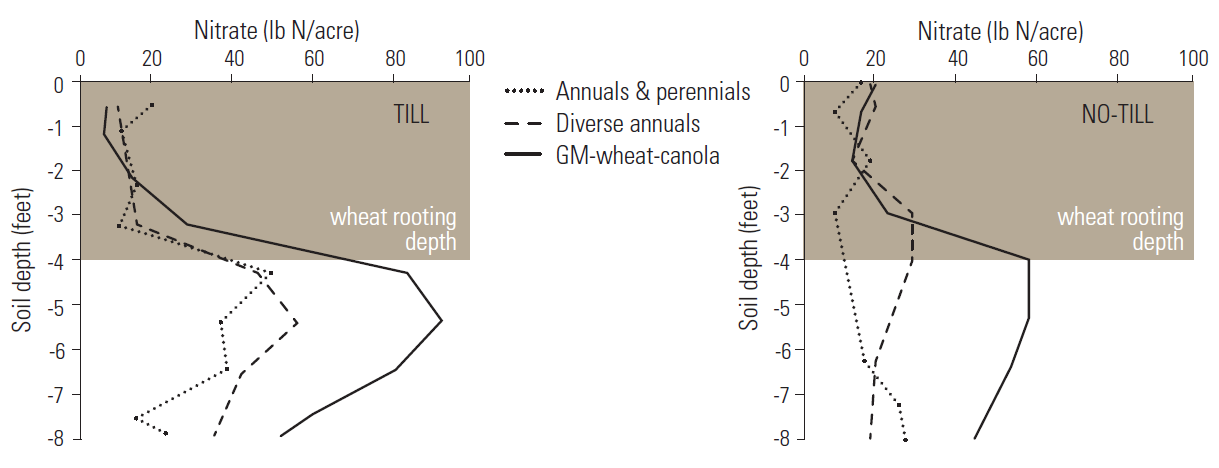
Soil nitrate increases with the time between tillage and the next crop. Therefore, spring tillage should lead to less leaching than fall tillage. However, if there is opportunity to plant a fall crop or cover crop, then late summer-early fall tillage makes sense (13, New Zealand).
Crop management recommendations:
- Recrop rather than fallow
- Follow fallow with fall-planted deep-rooted crops
- Diversify to include perennial and/or deep-rooted annual crops
- Space rows for optimal resource use and plant yield
- Reduce tillage
Irrigation management
Sprinkler systems allow better water control with higher N use and have lower leaching risk than furrow and flood irrigation systems (14, Montana). Irrigation should be managed to meet the crop need, but not exceed the soil's water holding capacity (Table 2). Upgrades in irrigation management may lead to less money spent on N. Montana State University has several resources to guide irrigation practices (http://waterquality.montana.edu/farm-ranch/irrigation/) and Colorado State University offers specific guidelines for irrigation management to retain soil N (15).
Irrigation management recommendations:
- Monitor soil water to determine when water is needed
- Match timing and amount with crop uptake
- Sprinkle rather than flood irrigate
- Apply water at rates that match soil water infiltration ability
Fertilization
Fertilizers should be managed for optimal plant growth and maximum N uptake.
N MANAGEMENT
A major goal is to reduce residual soil nitrate susceptible to leaching. By using available technology and best management practices, producers can make sure their N fertilizer dollars are spent growing a crop, rather than lost to leaching, and reduce the potential for nitrate contamination of groundwater. The 4R nutrient stewardship approach involves selecting the right rate-source-time-place combination from practices validated by research (www.ipni.net/4r). The Natural Resources Conservation Service’s (NRCS) Environmental Quality Incentives Program (EQIP) provides farmers with financial and technical assistance on agricultural production to protect environmental quality. Programs offered by the NRCS do change, so get current information from its website (www.nrcs.usda.gov/wps/portal/nrcs/main/mt/programs/) or a local NRCS office.
Rate Fertilizer N rates should be determined by annual soil testing and realistic yield goals to avoid over- fertilization and high levels of residual nitrate. In a study at Moccasin, Montana, there was little change in nitrate levels from fall to spring on fields that received 40 lb N/ acre the previous year, while fields that received 120 lb N/acre lost more than 25 lb N/acre (16). This illustrates that if the crops don’t use it, the field can lose it.
When calculating fertilizer rates, credit all sources of N available to the crop, including manures, legume input, organic matter and soil nitrate. In a study in the Judith River watershed, mineralization processes tended to produce similar amounts of nitrate in the soil as added fertilizer (4, Montana). See the MSU Extension publication Developing Fertilizer Recommendations for Agriculture and The Soil Scoop: Fertilizer Rate Calculations for steps to calculate fertilizer rates.
Spring soil tests are preferred to fall tests because they account for overwinter changes to soil nitrate levels. For example, nitrate increased an average 18 lb N/ acre annually from late summer to early spring in a three-year Montana study (17). Early fall samples are especially likely to underestimate growing season soil nitrate following a cover or pulse crop and leading to over-fertilization. Sample deeper than two feet where soils allow, to learn how much N escaped below a shallow-rooted crop such as lentil, yet may be ‘captured’ by winter wheat (18, Saskatchewan). Credit all of the available soil N at the two to three-foot depth if planting a deep-rooted crop, but only half of the N at the two to three-foot depth if planting a shallow-rooted crop. See Soil Sampling and Laboratory Selection and The Soil Scoop: Soil Testing for more details.
Source Enhanced efficiency fertilizers slowly release their nutrients over time due to coatings; others contain nitrification inhibitors which slow the conversion of N fertilizer to nitrate, ideally matching N availability with plant demand. Reduced leaching losses with polymer- coated urea has been documented in potato, corn and turfgrass production (19, Utah). Enhanced efficiency fertilizers deserve consideration, especially as the price difference compared to conventional N decreases. But, they are not the best fertilizer choice for all situations and timing of application is different than with conventional fertilizer. For discussion of the properties of these fertilizers, their effectiveness and suggested management see Enhanced Efficiency Fertilizers.
Plant residue and soil organic matter provide storage for nitrogen. Their decomposition releases N more slowly and in closer synchrony to crop N uptake than conventional N fertilizer, with less leaching loss (20, Saskatchewan; 21, Colorado, Washington). Legumes in particular can provide a long-term source of N (22, Montana) that is less likely to be lost to leaching, provided a crop is in place to use it.
Timing Ideally, conventional N fertilizer is applied right before the plants need it most, which is from seedling to tillering stages in cereal grains and seedling to early branching in oilseeds (Nutrient Uptake Timing by Crops: to assist with fertilizing decisions, or http://landresources.montana.edu/soilfertility/nutuptake.html). A conservative pre-plant N rate can be followed by fertilizer topdress applications with timing and rates based on crop growth stage and need, rather than calendar date. Although the effectiveness of split applications on leaching in a given year is influenced by timing of precipitation, over time, split applications should reduce N leaching. They reduce the risk of over-fertilizing in dry years, leaving less unused N in the soil to be leached. In years with average or above average precipitation, split applications better match plant N uptake, leaving less N from pre- plant to leach. In-season N monitoring tools such as leaf chlorophyll meters and flag-leaf N concentration (Nitrogen Management for Grain Protein) are helpful tests to see if topdressing will be beneficial or wasted and contribute to residual soil nitrate.
Placement Variable-rate fertilizer application methods help ensure N is applied where it is needed most and not in places where it will be lost. Often, most nitrate leaching comes from only a fraction of the total area of a field (23). Low productivity zones contribute more to nitrate leaching than high productivity zones. Adjusting N according to residual soil N and soil organic matter in a grid pattern is better than a uniform N application across the field (24, Colorado). However, to further limit N loss, producers can identify low producing areas ofa field that are limited by factors other than N, such as shallow soil depth, dry ridge tops, saline areas, oracidic areas and apply just enough N to meet that area’s production potential.
FIGURE 7. Soil nitrate after 37 years of fallow-wheat-wheat with only N or both P and N supplied based on soil test recommendations. Soil sampled in wheat rotation after fallow (5, Saskatchewan).
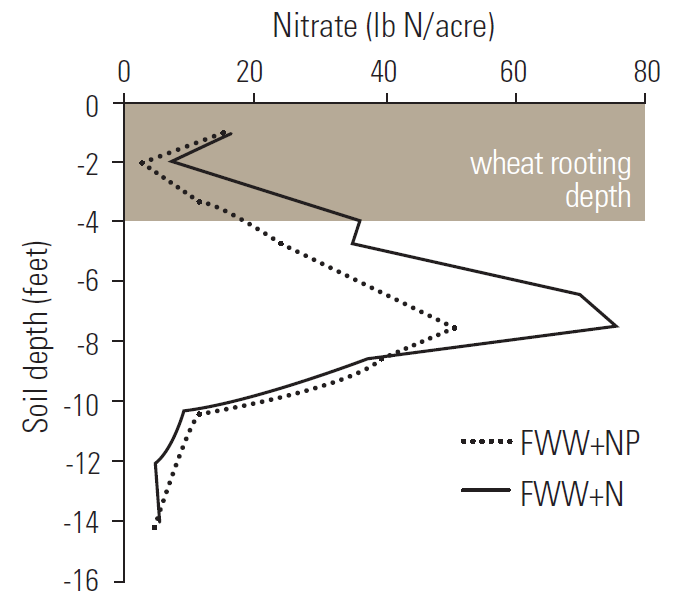
FIGURE 8. Addition of 13 to 18 lb S/acre on sulfur deficient soil increased yields and decreased residual soil nitrate in the top 2-feet (25, Saskatchewan).
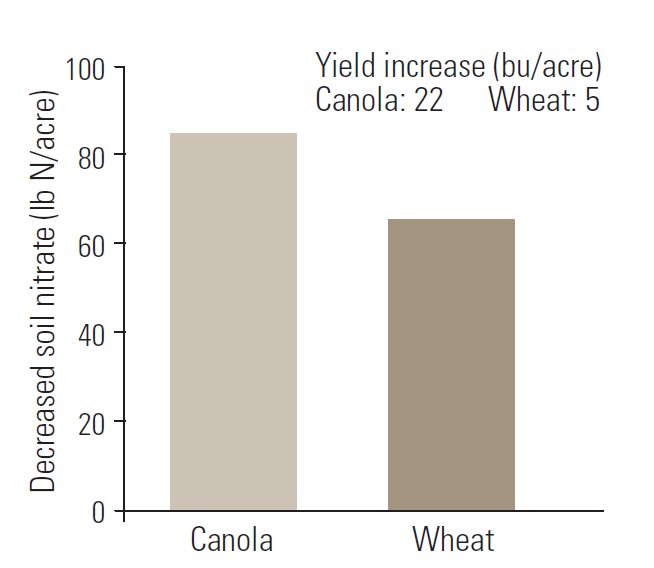
OTHER NUTRIENTS
A deficiency in other nutrients such as phosphorus, potassium, or sulfur can result in less crop growth, less water uptake, less N harvested, and more N left in the ground (Figure 7). Sulfur can be especially critical for N uptake and yield, thereby reducing N susceptibleto leaching (Figure 8). See Developing Fertilizer Recommendations for Agriculture for assistance with fertilizer rate calculations.
Fertilizer management recommendations:
- Know your soil type
- Soil sample annually in the spring to three feet or more in deeper soils
- Base N rate on soil tests and reasonable yield potential
- Credit N from all sources, such as manure and previous legume crops
- Apply N in spring or use a slow-release fertilizer
- Apply conventional N fertilizers close to peak crop N uptake
- Split applications - use conservative pre-plant N rate and in moist years topdress before rapid growth stage
- Retain crop residue and include legumes in rotation
- Use variable rate/zone specific technology
- Provide other nutrients for optimal yields
ECONOMICS
Based on water sampling in the Judith River watershed, the aquifer under the 65,000 acre Moccasin Terrace contains approximately 200 lb N/acre (26), equating to approximately $100/acre in lost N (assuming $0.50/lb N) or about $6.5 million for the aquifer under the terrace.
Producers in the Montana Judith River watershed had similar net revenues for pea-wheat and fallow-wheat in the first year and greater revenues for pea-winter wheat ($98/acre) than fallow-winter wheat ($65/acre) in the second year (4). The impact on net revenue dependson the precipitation pattern and amount, which affect the amount of N that could be lost and whether crops are water or N limited. These economic calculations do not account for the value of reduced nitrate in drinking water, and other benefits to soil health by recropping.
SUMMARY
Producers and their advisers can’t easily control some of the factors that affect soil nitrate leaching, such as soil properties and climate. However, there are numerous management practices that can be adjusted to minimize leaching. Cropping systems, especially alternativesto fallow, appear very important to reduce leaching. Since both organic matter mineralization and water percolation below the root zone depend on soil moisture levels, choosing crop rotations to avoid situations where high soil nitrate levels occur during times of heavy or prolonged precipitation can be a critical part of reducing losses of nitrogen from the root zone. If water movement below the root zone is stopped, nitrate leaching willalso stop, regardless of soil nitrate levels. Managing the magnitude and timing of fertilizer and irrigation applications can increase the amount of nitrogen thatis used by crops and maximize returns to farmers while reducing potential impacts to groundwater.
ACKNOWLEDGEMENTS
We appreciate the expertise of the following for review and production of this bulletin:
- Adam Sigler, Water Quality Extension Associate, Montana State University, Bozeman
- Kari Lewis, Glacier County Extension Agent, Cut Bank, Montana
- Mike Choriki, CCA, Owner of B & C Ag Consultants, Billings, Montana
- Stephanie Ewing, Associate Professor, Montana State University, Bozeman
- Tom Butcher, producer, Moore, Montana
- MSU Extension Communications and Publications
REFERENCES
- Rengel, Z. 2003. Handbook of Soil Acidity. CRC Press. Boca Raton, Florida. 512pp.
- Ewing, S. Unpublished data. Associate Professor, Montana State University, Bozeman, MT.
- Jones, C. Unpublished data. Associate Professor and Extension Soil Fertility Specialist, Montana State University, Bozeman, MT.
- John, A., C.A. Jones, S.A. Ewing, W.A. Sigler,A. Bekkerman, and P.R. Miller. 2017. Fallow replacement and alternative nitrogen management for reducing nitrate leaching in a semiarid region. Nutrient Cycling in Agroecosystems 108:279–296. https://doi.org/10.1007%2Fs10705-017-9855-9.
- Campbell, C.A., F. Selles, R.P. Zentner, R. De Jong,R. Lemke, and C. Hamel. 2006. Nitrate leaching in the semiarid prairie: Effect of cropping frequency, crop type, and fertilizer after 37 years. Canadian Journal of Soil Science 86: 701–710. https://doi.org/10.4141/S05-008.
- Tonitto, C., M.B. David, and L.E. Drinkwater. 2006. Replacing bare fallows with cover crops in fertilizer- intensive cropping systems: A meta-analysis of crop yield and N dynamics. Agriculture, Ecosystems and Environment 112:58-72. https://doi.org/10.1016/j.agee.2005.07.003.
- Eckhoff, J. 1997. Nitrates in Soil and Ground Water Under Irrigated Crops. Fertilizer Fact No. 9. Montana State University http://landresources.montana.edu/ fertilizerfacts/index.html
- Chen, C., and K. Neill. 2008. Response of Spring Wheat Yield and Protein to Row Spacing, Plant Density, and Nitrogen Application in Central Montana. Fertilizer Fact No. 37. Montana State University. http://landresources.montana.edu/ fertilizerfacts/index.html
- Halvorson, A.D., B.J. Wienhold, and A.L. Black. 2001. Tillage and nitrogen fertilization influences on grain and soil nitrogen in a spring wheat–fallowsystem. Agronomy Journal 93:1130-1135. https://doi.org/10.2134/agronj2001.9351130x.
- Halvorson, A.D., B.J. Wienhold, and A.L. Black. 2001. Tillage and nitrogen fertilization influence grain and soil nitrogen in an annual cropping system. Agronomy Journal 93:836–841. https://doi.org/10.2134/agronj2001.934836x.
- Malhi, S.S., S.A. Brandt, D. Ulrich, R. Lemke, andK.S. Gill. 2002. Accumulation and distribution of nitrate–nitrogen and extractable phosphorus in the soil profile under various alternative cropping systems. Journal of Plant Nutrition 25:2499–2520. https://doi.org/10.1081/PLN-120014709.
- Malhi, S.S., S.A. Brandt, R. Lemke, A.P. Moulin, and R.P. Zentner. 2009. Effects of input level and crop diversity on soil nitrate-N, extractable P, aggregation, organic C and N, and nutrientbalance in the Canadian Prairie. Nutrient Cycling in Agroecosystems 84:1-22. https://doi.org/10.1007/s10705-008-9220-0.
- Francis, G.S. 1995. Management practices for minimizing nitrate leaching after ploughing temporary leguminous pastures in Canterbury, New Zealand. Journal of Contaminant Hydrology 20:313-327. https://doi.org/10.1016/0169-7722(95)00076-3.
- Eckhoff, J., and C. Flynn. 2007. Fine-tuning Applied Nitrogen Rates for Sprinkler and Flood Irrigated Sugarbeet Production. Fertilizer Fact No. 43. Montana State University http://landresources.montana.edu/fertilizerfacts/index.html
- Bauder, T.A., R.M. Waskom, and A. Andales. 2014.Nitrogen and Irrigation Management. Fact Sheet0.514. Colorado State University Extension. http://extension.colostate.edu/topic-areas/agriculture/nitrogen-and-irrigation-management-0-514/
- Chen, C. Unpublished data. Superintendent Eastern Agricultural Research Center, Sidney, MT.
- Jones, C.A., C. Chen, J. Eckhoff, M. Greenwood, P. Lamb, A. Lenssen, K. McVay, P. Miller, B. Stougaard,J. Weeding, and M. Westcott. 2011. Changes in Soil Nitrate-N Levels from Late Summer to Early Spring in Montana. Fertilizer Fact No. 55. Montana State University http://landresources.montana.edu/fertilizerfacts/index.html
- Campbell, C.A., R.P. Zentner, P. Basnyat, H. Wang., F. Selles, B.G. McConkey, Y.T. Gan, andH.W. Cutforth. 2007. Water use efficiency and water and nitrate distribution in soil in the semiarid prairie: Effect of crop type over 21 years. Canadian Journal of Plant Science 87: 815–827. https://doi.org/10.4141/CJPS06034.
- LeMonte, J.J., V.D. Jolley, J.S. Summerhays, R.E. Terry, and B.G. Hopkins. 2016. Polymer coated urea in turfgrass maintains vigor and mitigates nitrogen's environmental impacts. PLoS ONE 11(1): e0146761. https://doi.org/10.1371/journal.pone.0146761.
- Campbell, C.A., R.P. Zentner, F. Selles, V.O. Biederbeck, and A.J. Leyshon. 1992. Comparative effects of grain Ientil-wheat and monoculture wheat on crop production, N economy and N fertility ina Brown Chernozem. Canadian Journal of Plant Science 72:1091-1107. https://doi.org/10.4141/cjps92-135.
- Delgado, J.A., S.J. Del Grosso, and S.M. Ogle. 2010. 15N isotopic crop residue cycling studies and modeling suggest that IPCC methodologies to assess residue contributions to N2O-N emissions shouldbe reevaluated. Nutrient Cycling in Agroecosystems86:383–390. https://doi.org/10.1007/s10705-009-9300-9.
- Miller, P., A. Bekkerman, C. Jones, M. Burgess, J. Holmes, and R. Engel. 2015. Pea in rotation with wheat reduced uncertainty of economic returns in southwest Montana. Agronomy Journal 107:541- 550. https://doi.org/10.2134/agronj14.0185.
- Power, J.F., R. Wiese, and D. Flowerday. 2001. Managing farming systems for nitrate control: A research review from Management Systems Evaluation Areas. Journal of Environmental Quality 30:1866-1880. https://doi.org/10.2134/jeq2001.1866.
- Delgado, J.A., R. Khosla, W.C. Bausch, D.G. Westfall, and D.J. Inman. 2005. Nitrogen fertilizer management based on site-specific management zones reduces potential for nitrate leaching. Journal of Soil and Water Conservation 60:402-410.
- Malhi, S.S., J.J. Schoenau and D. Leach. 2009. Maximizing Fertilizer Use Efficiency and Minimizing Potential for Nitrate Accumulation and Leachingin Soil by Balanced Fertilization. Proceedings of the 2009 Soils, Crops Workshop, February 25-26, Saskatoon, Saskatchewan.
- Sigler, W.A., S.A. Ewing, C.A. Jones, R.A. Payn, E.N.J. Brookshire, J.K. Klassen, D. Jackson-Smith, and G.S. Weissmann. 2018. Connections among soil, ground, and surface water chemistries characterize nitrogen loss from an agricultural landscape in the upper Missouri River basin. Journal of Hydrology 556:247- 261. https://doi.org/10.1016/j.jhydrol.2017.10.018.
EXTENSION MATERIALS
For a range of information from well testing to irrigation management, contact the MSU Extension Water Quality Program at http://waterquality.montana.edu/ or phone (406) 994-7381.
MSU Extension Soil Fertility has a variety of materials regarding water quality and nitrogen fertilization that may be helpful (http://landresources.montana.edu/soilfertility/publications.html, locate by title).
- Crop and Fertilizer Management Practices to Minimize Nitrate Leaching (MT201103AG)
- Developing Fertilizer Recommendations for Agriculture (MT200703AG)
- Enhanced Efficiency Fertilizers (EB0188)
- Nutrient Uptake Timing by Crops: to assist with fertilizing decisions (EB0191)
- Soil Sampling and Laboratory Selection (4449-1)
- The Soil Scoop:
Additional information on nutrient cycling and management practices are available in the Nutrient Management Modules (#4449-1 to 4449-15) and Soil and Water Management Modules (#4481-1 to 4481-5). http://landresources.montana.edu/soilfertility/
You may request these publications and many others, from your local county Extension agent, MSU Extension Publications at the address below, or online. A shipping and handling fee will be charged for hard copies.

